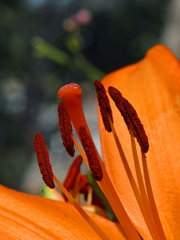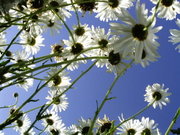 |
|
|
|
Fri, 19 Apr, 2024
|

|
|

Pay as you go
No monthly charges. Access for the price of a phone call
Go>
Unmetered
Flat rate dialup access from only £4.99 a month Go>
Broadband
Surf faster from just £13.99 a month Go> |
Save Even More
Combine your phone and internet, and save on your phone calls
More Info> |
This weeks hot offer
 24: Series 5
24: Series 5
In association with Amazon.co.uk £26.97 |
|
Contents
 Flower anatomy Flower anatomy
 Flower function Flower function
 Flowers in gardening and horticulture Flowers in gardening and horticulture
 Flowers in the arts Flowers in the arts
 Flowers in everyday life Flowers in everyday life
 Flowers as symbols Flowers as symbols
 Flower anatomy - Contents Flower anatomy - Contents
Flowering plants are heterosporangiate (producing two types of reproductive spores) and the pollen (male spores) and ovules (female spores) are produced in different organs, but these are together in a bisporangiate strobilus that is the typical flower.A flower is regarded as a modified stem (Eames, 1961) with shortened internodes and bearing, at its nodes, structures that may be highly modified leaves. In essence, a flower structure forms on a modified shoot or axis with an apical meristem that does not grow continuously (growth is determinate). The stem is called a pedicel, the end of which is the torus or receptacle. The parts of a flower are arranged in whorls on the torus. The four main parts or whorls (starting from the base of the flower or lowest node and working upwards) are as follows:
 Poppy
- calyx – the outer whorl of sepals; typically these are green, but are petal-like in some species.
- corolla – the whorl of petals, which are usually thin, soft and colored to attract insects that help the process of pollination.
- androecium (from Greek andros oikia: man's house) – one or two whorls of stamens, each a filament topped by an anther where pollen is produced. Pollen contains the male gametes.
- gynoecium (from Greek gynaikos oikia: woman's house) – one or more pistils. The female reproductive organ is the carpel: this contains an ovary with ovules (female gametes). A pistil may consist of a number of carpels merged together, in which case there is only one pistil to each flower, or of a single individual carpel (the flower is then called apocarpous). The sticky tip of the pistil, the stigma, is the receptor of pollen. The supportive stalk, the style becomes the pathway for pollen tubes to grow from pollen grains adhering to the stigma, to the ovules, carrying the reproductive material.
 Tulip - androecium and gynoecium
Although the floral structure described above is considered the "typical" structural plan, plant species show a wide variety of modifications from this plan. These modifications have significance in the evolution of flowering plants and are used extensively by botanists to establish relationships among plant species. For example, the two subclasses of flowering plants may be distinguished by the number of floral organs in each whorl: dicotyledons typically having 4 or 5 organs (or a multiple of 4 or 5) in each whorl and monocotyledons having three or some multiple of three. The number of carpels in a compound pistil may be only two, or otherwise not related to the above generalization for monocots and dicots.In the majority of species, individual flowers have both pistils and stamens as described above. These flowers are described by botanists as being perfect, bisexual, or hermaphrodite. However, in some species of plants the flowers are imperfect or unisexual: having only either male (stamens) or female (pistil) parts. In the latter case, if an individual plant is either male or female the species is regarded as dioecious. However, where unisexual male and female flowers appear on the same plant, the species is considered monoecious.Some flowers with both stamens and a pistil are capable of self-fertilization, which does increase the chance of producing seeds but limits genetic variation. The extreme case of self-fertilization occurs in flowers that always self-fertilize, such as the common dandelion. Conversely, many species of plants have ways of preventing self-fertilization. Unisexual male and female flowers on the same plant may not appear at the same time, or pollen from the same plant may be incapable of fertilizing its ovules. The latter flower types, which have chemical barriers to their own pollen, are referred to as self-sterile or self-incompatible (see also: Plant sexuality).
 Close-up of a Day lily flower showing six stamens and the stigma and style of a pistil
Additional discussions on floral modifications from the basic plan are presented in the articles on each of the basic parts of the flower. In those species that have more than one flower on an axis, the collection of flowers is termed an inflorescence. In this sense, care must be exercised in considering what is a flower. In botanical terminology, a single daisy or sunflower for example, is not a flower but a flower head—an inflorescence comprised of numerous small flowers (sometimes called florets). Each small flower may be anatomically as described above.
Floral formula
A floral formula is a way to represent the structure of a flower using specific letters, numbers, and symbols. Typically, a general formula will be used to represent the flower structure of a plant family rather than a particular species. The following representations are used:Ca = calyx (sepal whorl; e.g. Ca5 = 5 sepals)
Co = corolla (petal whorl; e.g., Co3(x) = petals some multiple of three )
Z = add if zygomorphic (e.g., CoZ6 = zygomorphic with 6 petals)
A = androecium (whorl of stamens; e.g., A∞ = many stamens)
G = gynoecium (carpel or carpels; e.g., G1 = monocarpous)
x - to represent a "variable number"
∞ - to represent "many"
A floral formula would appear something like this:
- Ca5Co5A10 - ∞G1
Several other symbols are used that will have to await drawings to illustrate here (see [1]).
 Flower function - Contents Flower function - Contents
 Grains of pollen on stigma of a lily
The function of a flower is to mediate the union of male and female gametes. The process is termed pollination. Many flowers are dependent upon the wind to move pollen between flowers of the same species. Others rely on animals (especially insects) to accomplish this feat. The period of time during which this process can take place (the flower is fully expanded and functional) is called anthesis.Many flowers in nature have evolved to attract animals to pollinate the flower, the movements of the pollinating agent contributing to the opportunity for genetic recombinations within a dispersed plant population. Flowers that are insect pollinated are called entomophilous (literally "insect loving"). Flowers commonly have glands called nectaries on their various parts that attract these animals. Birds and bees are common pollinators: both having colour vision, thus opting for "colorful" flowers. Some flowers have patterns, called nectar guides, that are evident in the ultraviolet range, visible to bees but not to humans. Flowers also attract pollinators by scent. In any case, pollinators are attracted to the plant, perhaps in search of nectar, which they eat. The arrangement of the stamens ensures that pollen grains are transferred to the bodies of the pollinator. In gathering nectar from many flowers of the same species, the pollinators transfer pollen between all of the flowers it visits.Flower scent is not always pleasant to our sense of smell. Some plants, such as Rafflesia, the titan arum, and the North American pawpaw (Asimina triloba) are pollinated by flies, so produce a scent imitating rotting meat.Other flowers are pollinated by the wind, and the flowers of these species (for example, grasses) have no need to attract pollinators and therefore tend not to be "showy". Wind pollinated flowers are referred to as anemophilous. Whereas the pollen of entomophilous flowers tends to be large grained, sticky, and contain significant protein (another "reward" for pollinators), Anemophilous flower pollen is usually small grained, very light, and of little nutritional value to insects, though it may still be gathered, in times of dearth. Honeybees and bumblebees actively gather anemophilous corn (maize) pollen, though it is of little value to them.There is much confusion about the role of flowers in allergies. For example the showy and entomophilous goldenrod (Solidago) is frequently blamed for respiratory allergies, of which it is innocent, since its pollen cannot be airborne. Instead the allergen is usually the pollen of the contemporary bloom of anemophilous ragweed (Ambrosia) which can drift for many kilometers.
 Flowers in gardening and horticulture - Contents Flowers in gardening and horticulture - Contents
Main and related articles at: Gardening, Horticulture, List of flowers, and Floristry
 Flowers in the arts - Contents Flowers in the arts - Contents
The great variety of delicate and beautiful flowers has inspired the works of many poets, especially from the Romantic era. Famous examples include and William Wordsworth's I Wandered Lonely as a Cloud and William Blake's Ah! Sun-Flower:
Ah, Sun-flower weary of time,
Who countest the steps of the Sun,
Seeking after that sweet golden clime
Where the traveller's journey is done:
Where the Youth pined away with desire,
And the pale Virgin shrouded in snow
Arise from their graves, and aspire
Where my Sun-flower wishes to go.
- —William Blake, Ah! Sun-Flower
The Roman goddess of flowers, gardens, and the season of Spring is Flora. The Greek goddess of spring, flowers and nature is Chloris.
 Flowers in everyday life - Contents Flowers in everyday life - Contents
In modern times, people have sought ways to cultivate, buy, wear, or just be around flowers and blooming plants, partly because of their agreeable smell. Around the world, florists sell flowers for a wide range of events and functions that, cumulatively, encompass one's lifetime:
- For new births or Christenings
 Lilium hybrid "Stargazer" is extremely fragrant.
- As a corsage or boutonniere to be worn at social functions or for holidays
- For wedding flowers for the bridal party, and decorations for the hall
- As brightening decorations within the home
- As a gift of remembrance for bon voyage parties, welcome home parties, and "thinking of you" gifts
- For funeral flowers and flowers for the grieving
Florists depend on an entire network of commercial growers and shippers to support this trade. To get flowers that are out of season in their country, florists contact wholesalers who have direct connections with growers in other countries to provide those flowers.
 Flowers as symbols - Contents Flowers as symbols - Contents
 Daisies symbolize innocence in Western culture.
Many flowers have important symbolic meanings in Western culture. The practice of assigning meanings to flowers is known as floriography. Some of the more common examples include:
- Red roses are given as a symbol of love, beauty, and passion.
- Poppies are a symbol of consolation in time of death. In the UK, Australia and Canada, red poppies are worn to commemorate soldiers who have died in times of war.
-
Irises/ Lily are used in burials as a symbol refering to "resurection/life". It is also assosiated with stars (sun) and its petals blooming/shining.
-
Daisies are a symbol of innocence.
Flowers within art are also representative of the female genitalia, as seen in the works of artists such as Georgia O'Keefe, Imogene Cunningham, and Judy Chicago. |
Change Text Size:
[A]
[default]
[A] |




 |
|
|
|
|